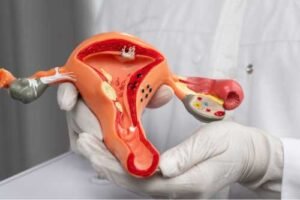Uterine Fibroids and Fertility: Diagnosing & Treatment
Uterine Fibroids and Fertility: Diagnosing, Treating and When to Act
Fertility is a journey filled with hope, emotions and many unanswered questions. For many women, the presence of uterine fibroids becomes one of these unexpected barriers that they did not see coming. Fibroids are common, and in most cases they stay silent. However, when they begin to affect menstrual cycles, pelvic comfort or fertility, they become difficult to ignore. Understanding how fibroids affect fertility is important whether you are trying naturally, planning to explore fertility treatment or considering IVF treatment in Bangalore. At a fertility centre in Bangalore like Ayaansh Hospital, doctors often meet women who have tried for years to conceive but only discover later that fibroids were silently interfering with their chances.
Uterine fibroids are non cancerous growths that can appear inside or on the uterus. They vary in size and location, and these two factors play a major role in determining how they affect conception. Some fibroids may be as small as a seed, while others may grow large enough to distort the shape of the uterus. Many women do not know they have fibroids until a routine scan reveals them. Others experience symptoms like heavy bleeding, prolonged periods, severe cramps or pelvic pressure. The tricky part is that symptoms are not always obvious, which is why diagnosing fibroids correctly is important for women who want to avoid delays in their fertility journey.
This blog explains everything you need to know about fibroids and fertility in a simple, conversational way. You will learn how fibroids form, how they impact natural conception and IVF success, when to take treatment and what treatment options are available. It also covers how fertility specialists at a fertility centre in Bangalore make decisions about which fibroids need treatment and which do not. Fibroids do not always require surgery, but acting at the right time can protect fertility and help you move closer to parenthood without unnecessary stress or confusion.
The goal is to give you clear, reliable and easy to understand information, so that you feel empowered to discuss the next step with your doctor. Whether you are just starting your fertility evaluation or are ready for IVF treatment in Bangalore, this guide will help you make confident decisions. Fibroids can be challenging, but with the right diagnosis and timely intervention, they do not have to stand in the way of your dream of becoming a parent.

What Are Uterine Fibroids and How They Develop
Here are the key points about what fibroids are and how they develop. Each point is explained clearly to help you understand the basics before moving into fertility related concerns.
- Non Cancerous Growths
Fibroids are benign growths that form in or around the uterus. They are not cancer and usually do not turn into cancer, but their presence can create functional problems. - Hormone Driven Development
Fibroids grow under the influence of hormones. Estrogen and progesterone often make them grow faster, which is why they may become more noticeable during reproductive years. - Different Types and Locations
Fibroids can be intramural, submucosal or subserosal. Their position decides how they affect fertility. For example, submucosal fibroids may distort the uterine lining and affect implantation. - Size Variation
Fibroids may remain small or grow significantly. Large fibroids can press on the uterus, fallopian tubes or nearby organs, causing symptoms and fertility difficulties. - Genetic and Lifestyle Factors
Family history, obesity and hormonal imbalance may increase the chance of developing fibroids. However, many women with no risk factors still develop them.
Understanding the nature of fibroids helps you make sense of why doctors at a fertility centre in Bangalore focus so much on size and location before suggesting treatment.
How Fibroids Affect Fertility: Explained in Subheadings
Interference With Implantation
Some fibroids grow inside the uterine cavity or push against the lining. This can interfere with the embryo’s ability to implant properly. Even during IVF treatment, these fibroids can reduce the chances of the embryo settling in.
Distortion of the Uterine Shape
When fibroids become large or grow in clusters, they change the structure of the uterus. This makes it difficult for sperm to travel, for the egg to move naturally or for an embryo to implant.
Blockage of the Fallopian Tubes
Fibroids near the openings of the tubes or on the outer walls of the uterus may block the tubes. This prevents the meeting of sperm and egg, causing fertility delays.
Impact on Blood Flow to the Uterus
Healthy blood flow to the uterine lining is important for pregnancy. Some fibroids disrupt the supply of blood to the lining, reducing the chances of implantation.
Interference With Ovulation
Though less common, fibroids growing near the ovaries may affect egg release. This can lead to irregular ovulation patterns.

Diagnosing Fibroids: A Detailed Paragraph Explanation
Diagnosing fibroids requires a combination of scans, tests and clinical evaluation. Most women first learn about their fibroids during a pelvic ultrasound. This scan helps identify the number, size and location of fibroids. However, in some cases, a 3D ultrasound or MRI becomes necessary when fibroids are small, hidden or located in a position that is difficult to view. Fertility specialists at a fertility centre in Bangalore often recommend a saline infusion sonogram to understand whether the fibroids are distorting the uterine cavity. In certain cases, a hysteroscopy is advised, which allows the doctor to look inside the uterus with a tiny camera and assess whether the fibroids are affecting the lining. Diagnosing fibroids correctly is important because not all fibroids affect fertility. What matters is their position, how they change the shape of the uterus and whether they interfere with ovulation, implantation or embryo development. Once doctors identify these details, they can decide the best approach for treatment and whether immediate action is needed.
Treatment Options for Uterine Fibroids: Presented in Pointers
These treatment options are explained in simple language so you can understand what each option means and when it is used.
- Watchful Monitoring
If the fibroids are small, not growing and not affecting fertility, doctors may choose to monitor them instead of treating them immediately. - Medication to Manage Symptoms
Hormonal medicines may help reduce heavy bleeding or pain. However, medicines do not remove fibroids. They only control symptoms until pregnancy planning begins. - Hysteroscopic Removal
Fibroids inside the uterine cavity can be removed using hysteroscopy. This is a minimally invasive procedure and recovery is quick. - Laparoscopic Myomectomy
Fibroids located in the wall of the uterus or on its outer layer may need laparoscopic removal. This method protects the uterus and is preferred for women planning pregnancy. - Lifestyle Modifications
Maintaining a healthy weight, managing stress and balancing hormones may help slow fibroid growth, though this does not replace medical treatment.
A Table Summarising Types of Fibroids and Their Impact on Fertility
|
Type of Fibroid |
Location |
Impact on Fertility |
How It Is Treated |
|
Submucosal |
Inside the uterine cavity |
High interference with implantation |
Hysteroscopic removal |
|
Intramural |
In the uterine wall |
May impact fertility if large in size |
Laparoscopic myomectomy |
|
Subserosal |
Outside the uterus |
Usually minimal impact on fertility |
Surgery only if very large |
|
Pedunculated |
Attached by a stalk |
Rarely affects fertility |
Removed if painful or large |
|
Multiple Fibroids |
Several in different locations |
Distorts uterus and affects conception |
Combination of surgical methods |

When You Should Act Quickly: Explained in Paragraph Style
Not all fibroids are urgent, but certain situations require timely treatment to protect fertility. If you experience heavy bleeding that interferes with daily life, it may mean the fibroids are growing or affecting the uterine lining. Severe pelvic pain or pressure is another sign that they are becoming large or causing complications. If you have been trying to conceive for many months without success and scans show fibroids near the lining or tubes, it is important to act before the condition worsens. Women planning IVF treatment in Bangalore should also act promptly because fibroids that distort the cavity can reduce the chances of a successful embryo transfer. Acting early helps avoid unnecessary delays and increases your chances of pregnancy. At a fertility centre in Bangalore, doctors create a personalised plan and help you decide the right time to take treatment based on your age, symptoms and fertility goals.
Why Ayaansh Hospital Is the Best Fertility Centre in Bangalore
Ayaansh Hospital has become a trusted fertility centre in Bangalore because of its dedicated team, modern facilities and a strong focus on personalised care. The doctors here are experienced in advanced reproductive treatments and minimally invasive surgeries, especially myomectomy for fibroids. They carefully evaluate each patient’s condition and create treatment plans that protect fertility while addressing the root cause. The hospital uses advanced scanning technologies and surgical tools to ensure high precision and safety. What truly sets Ayaansh Hospital apart is its warm and supportive approach, which helps patients feel confident and understood throughout their journey. Whether you need fibroid surgery, fertility evaluation or IVF treatment in Bangalore, Ayaansh Hospital ensures that you receive trusted guidance and world class care.
Conclusion
Fibroids are common and often harmless, but when they begin to interfere with fertility, timely action becomes important. A clear understanding of how fibroids form, how they affect the uterus and how they impact conception can help you make better decisions for your reproductive health. Many women are surprised to learn that small fibroids may not require any treatment at all, while others may need removal before trying to conceive or starting IVF treatment in Bangalore. What matters most is proper diagnosis and evaluation, because the size, number and location of fibroids decide how they affect your chances of pregnancy.
At a fertility centre in Bangalore like Ayaansh Hospital, specialists use detailed scans, advanced tests and minimally invasive procedures to give couples clarity and direction. Acting at the right time protects your fertility and reduces complications later. Whether you are experiencing heavy periods, pelvic pain, irregular cycles or unexplained infertility, checking for fibroids can give you the insight you need. With the right treatment and guidance, fibroids do not have to stand in the way of your dream of becoming a parent.
Remember that every woman’s body is different and every fertility journey is unique. Understanding your condition helps reduce stress and gives you the confidence to take the next step. With expert support from a trusted fertility team, the path to parenthood becomes clearer and more hopeful. Ayaansh Hospital continues to guide women with compassion, accuracy and advanced care, ensuring that no fertility challenge remains unexplained or untreated. Your fertility journey deserves support, clarity and the right medical care at the right time, and that is exactly what you can expect when you seek help early and take charge of your wellbeing.



